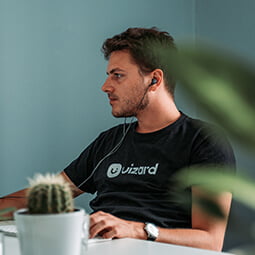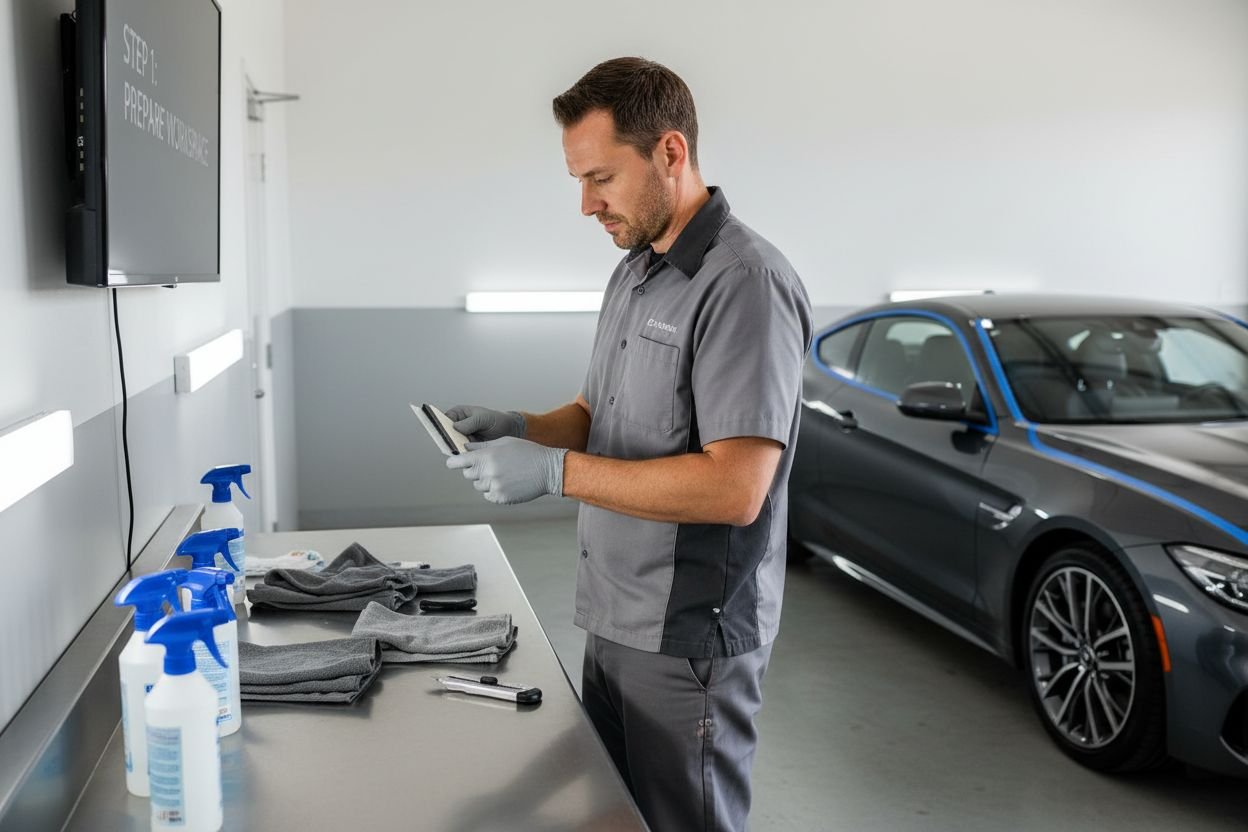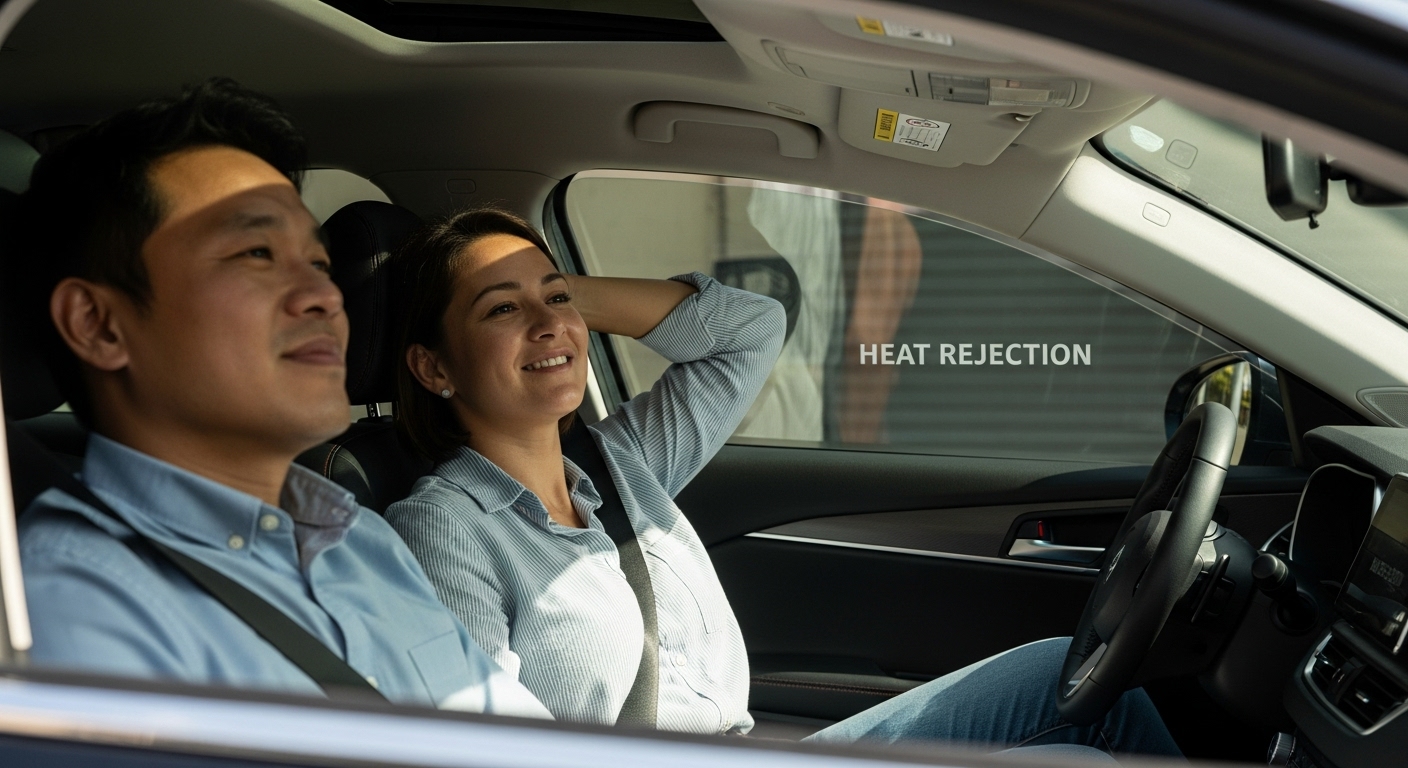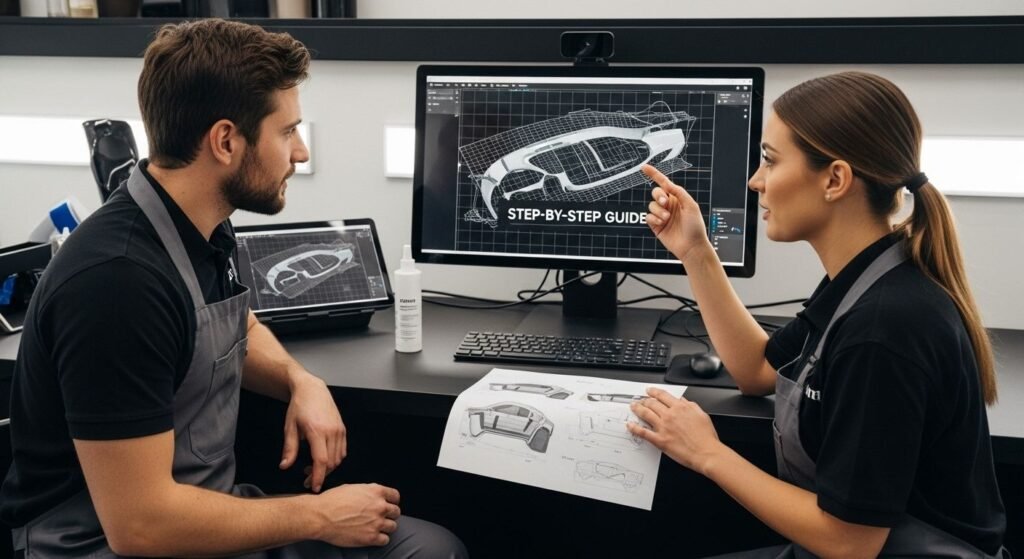
Custom Paint Protection Film patterns have changed the way professionals safeguard car paint, offering a level of accuracy that few expected possible. Yet most installers do not realise that Aeoncut’s algorithms can deliver digital patterns with millimeter-level precision across intricate curves and angles. The real surprise is that these powerful tools not only maximise material coverage but also let you tailor every detail for each client, turning what was once a manual grind into a fast, exact, and creative process.
Table of Contents
- Understanding PPF Pattern Design With Aeoncut
- Step-By-Step Guide To Creating Custom Patterns
- Tips For Achieving Accurate PPF Cuts
- Integrating Aeoncut Patterns Into Installation Workflow
Quick Summary
| Takeaway | Explanation |
|---|---|
| Prepare your digital workspace meticulously | Setting up your digital workspace accurately is essential for optimal pattern generation and installation results. |
| Utilise advanced computational techniques for patterns | Leverage Aeoncut’s algorithms to create precise patterns that fit vehicle contours accurately, maximising coverage and minimising waste. |
| Customize PPF patterns for specific client needs | Take advantage of Aeoncut’s features to adjust patterns, ensuring that the final design meets unique client requirements effectively. |
| Understand material characteristics for better cuts | A deep knowledge of PPF materials enhances cutting accuracy, improving overall installation quality and durability. |
| Incorporate digital tools into workflow for efficiency | Seamlessly integrating digital pattern generation with physical installation processes optimizes workflow and reduces potential installation errors. |
Understanding PPF Pattern Design with Aeoncut
Paint Protection Film (PPF) pattern design represents a sophisticated technical process that transforms raw automotive surface protection into precision-engineered solutions. At its core, PPF pattern design requires intricate understanding of vehicle geometries, material properties, and cutting technologies that ensure comprehensive coverage and optimal protection.
The Mathematical Precision of Pattern Generation
PPF pattern design is fundamentally a complex mathematical challenge. Vehicle surfaces are not uniform geometric shapes but intricate three-dimensional contours with multiple curves, angles, and transitions. Research from the Fashion Design Pattern Methodology reveals that successful pattern design relies on strategic grid-based frameworks and computational techniques that map surface complexities with extraordinary accuracy.
The F-Technique research demonstrates how systematic grid approaches can minimize material waste while maximizing coverage. In PPF design, this translates to creating patterns that precisely conform to every vehicle panel’s unique topography. Aeoncut leverages advanced algorithms that break down vehicle surfaces into digital grids, enabling mathematically precise pattern generation that reduces material waste and ensures seamless film application.
Advanced Computational Mapping Techniques
Modern PPF pattern design transcends traditional manual tracing methods. Contemporary software like Aeoncut utilizes sophisticated computational mapping techniques that capture vehicle panel nuances with millimeter-level precision. Research investigating pattern design techniques emphasizes the critical role of comprehensive education and technological proficiency in creating accurate patterns.
These computational techniques involve multiple strategic processes:
- Digital Surface Scanning: Capturing exact vehicle panel geometries through high-resolution digital mapping
- Algorithmic Pattern Generation: Transforming scanned data into precise cutting templates
- Material Optimization: Calculating optimal film placement to minimize waste and maximize coverage
Professional installers recognize that successful PPF application depends not just on material quality but on the precision of pattern design. Aeoncut represents a technological leap, offering professionals a comprehensive PPF pattern solution that bridges computational precision with practical automotive protection requirements.
The evolution of PPF pattern design reflects broader technological trends in automotive customization. What was once a manual, time-consuming process has transformed into a highly automated, mathematically driven approach that delivers unprecedented accuracy and efficiency. Aeoncut embodies this technological progression, providing installers with tools that simplify complex pattern generation while maintaining exceptional quality standards.
Step-by-Step Guide to Creating Custom Patterns
Creating custom Paint Protection Film (PPF) patterns requires precision, technical skill, and sophisticated software tools. Professional installers understand that successful pattern generation involves more than simple tracing or manual cutting. With Aeoncut, the process becomes streamlined, efficient, and remarkably accurate.
Preparing Your Digital Workspace
Before diving into pattern creation, setting up your digital workspace is crucial. According to Premier Paint Guard’s professional guidelines, meticulous preparation determines the quality of your final PPF application. In Aeoncut, this preparation involves several key steps:
- Vehicle Model Selection: Choose the exact make, model, and year of the vehicle from Aeoncut’s comprehensive database
- High-Resolution Scanning: Ensure your vehicle reference images are clear and accurately represent surface contours
- Software Configuration: Set appropriate resolution and precision settings matching your specific installation requirements
Professional installers recognize that digital accuracy translates directly into physical film performance. Each millimeter matters when protecting valuable automotive surfaces.
Leveraging Computational Pattern Generation
Aeoncut transforms traditional pattern design through advanced computational techniques. The software uses sophisticated algorithms that analyze vehicle geometries, generating patterns with unprecedented precision. These algorithms break down complex surface geometries into manageable digital grids, allowing installers to create patterns that conform perfectly to every vehicle panel.
The pattern generation process involves multiple sophisticated steps:
- Importing precise vehicle surface data
- Applying computational mapping algorithms
- Generating optimized cutting templates
- Previewing and refining pattern designs
To help clarify the critical stages in creating custom PPF patterns with Aeoncut, the table below summarises the essential steps involved in the process.
| Step | Description |
|---|---|
| Vehicle Model Selection | Choose the make, model, and year from Aeoncut’s database |
| High-Resolution Scanning | Use clear, accurate reference images to capture surface contours |
| Software Configuration | Set resolution and precision options to match installation needs |
| Import Vehicle Surface Data | Bring in digital scans or reference images into the Aeoncut software |
| Computational Mapping Algorithms | Apply Aeoncut’s algorithms to analyse the vehicle’s geometry and generate digital grids |
| Generate Optimised Templates | Produce cutting templates that conform precisely to each vehicle panel |
| Preview and Refine Design | Review, adjust, and fine-tune patterns as needed before final approval for cutting |
This computational approach eliminates traditional manual tracing limitations. Installers can now generate patterns that account for subtle curves, complex angles, and intricate panel transitions with minimal material waste.
Customization and Fine-Tuning
While Aeoncut provides automated pattern generation, professional installers appreciate the software’s robust customization capabilities. Users can manually adjust pattern edges, add or remove coverage areas, and fine-tune design elements to match specific client requirements.
Key customization features include:
- Precise edge manipulation
- Coverage area expansion or reduction
- Integration of custom design elements
- Real-time material usage estimation
These features empower installers to transform standard patterns into personalized protection solutions. Learn more about advanced PPF software techniques that can elevate your installation precision.
The future of PPF pattern design lies in computational accuracy, efficiency, and adaptability. Aeoncut represents this technological evolution, providing professionals with tools that transform complex pattern generation from a challenging task into a streamlined, predictable process.
Tips for Achieving Accurate PPF Cuts
Achieving precise Paint Protection Film (PPF) cuts requires more than just advanced software – it demands a comprehensive understanding of material properties, cutting techniques, and installation nuances. Professional installers recognize that accuracy is paramount in delivering high-quality protective solutions for automotive surfaces.

Understanding Material Characteristics
Patent research on PPF application techniques reveals critical insights into film flexibility and substrate interactions. The material’s unique optical and mechanical properties significantly influence cutting precision. Professional installers must consider multiple factors:
- Film Elasticity: Understanding how PPF stretches and conforms to different surface geometries
- Material Tension: Managing film tension during cutting to prevent distortion
- Surface Compatibility: Ensuring the film adheres smoothly to complex automotive contours
These characteristics demand sophisticated cutting approaches that go beyond traditional manual methods. Precision becomes especially crucial when working with intricate vehicle panels featuring complex curves and transitions.
The following table outlines key PPF material characteristics and the corresponding installer considerations, making it easier to quickly assess what matters for precision cutting.
| Material Characteristic | Installer Consideration |
|---|---|
| Film Elasticity | Be aware of how much the film stretches over curves and angles |
| Material Tension | Manage tension to prevent distortion during cutting |
| Surface Compatibility | Ensure film adheres smoothly to complex contours |
Advanced Cutting Technique Strategies
Patent documentation highlighting PPF application methods emphasizes the importance of simultaneous techniques that maintain film integrity during cutting. Professional installers should focus on:
- Maintaining consistent blade sharpness
- Using minimal pressure during cutting
- Implementing digital alignment tools
- Performing incremental, controlled cuts
Aeoncut’s computational algorithms support these strategies by providing real-time guidance and precision mapping. The software helps installers navigate complex cutting scenarios by offering visual references and alignment assistance.
Minimizing Common Cutting Errors
Optical quality represents another critical consideration in PPF cutting. Patent research on film properties demonstrates that cutting accuracy directly impacts the film’s aesthetic and protective performance. Common errors include:
- Uneven edge transitions
- Excessive material stress
- Improper alignment
- Inconsistent cutting depths
To mitigate these challenges, professional installers can explore advanced cutting software techniques that provide comprehensive error prevention mechanisms.
Successful PPF installation transcends technical skill – it represents a fusion of technological precision, material understanding, and meticulous craftsmanship. By leveraging computational tools and maintaining a deep respect for material properties, installers can consistently deliver exceptional protective solutions that meet the most demanding automotive aesthetic and protective standards.
Integrating Aeoncut Patterns into Installation Workflow
Successful Paint Protection Film (PPF) installation requires more than just precise pattern generation – it demands seamless integration of digital tools into the professional installer’s workflow. Aeoncut represents a transformative approach to bridging computational design with practical application techniques.
Digital Pattern Translation Strategies
Patent research on film installation technologies reveals sophisticated methods for translating digital patterns into real-world applications. Modern installers must develop strategies that transform computational designs into precise physical implementations. This process involves several critical steps:
- Downloading accurate digital templates
- Verifying pattern alignment with vehicle surfaces
- Preparing installation environments
- Managing material handling and positioning
The digital-to-physical translation requires meticulous attention to detail. Aeoncut’s computational algorithms provide installers with visual guides and precise positioning references that dramatically reduce installation errors.
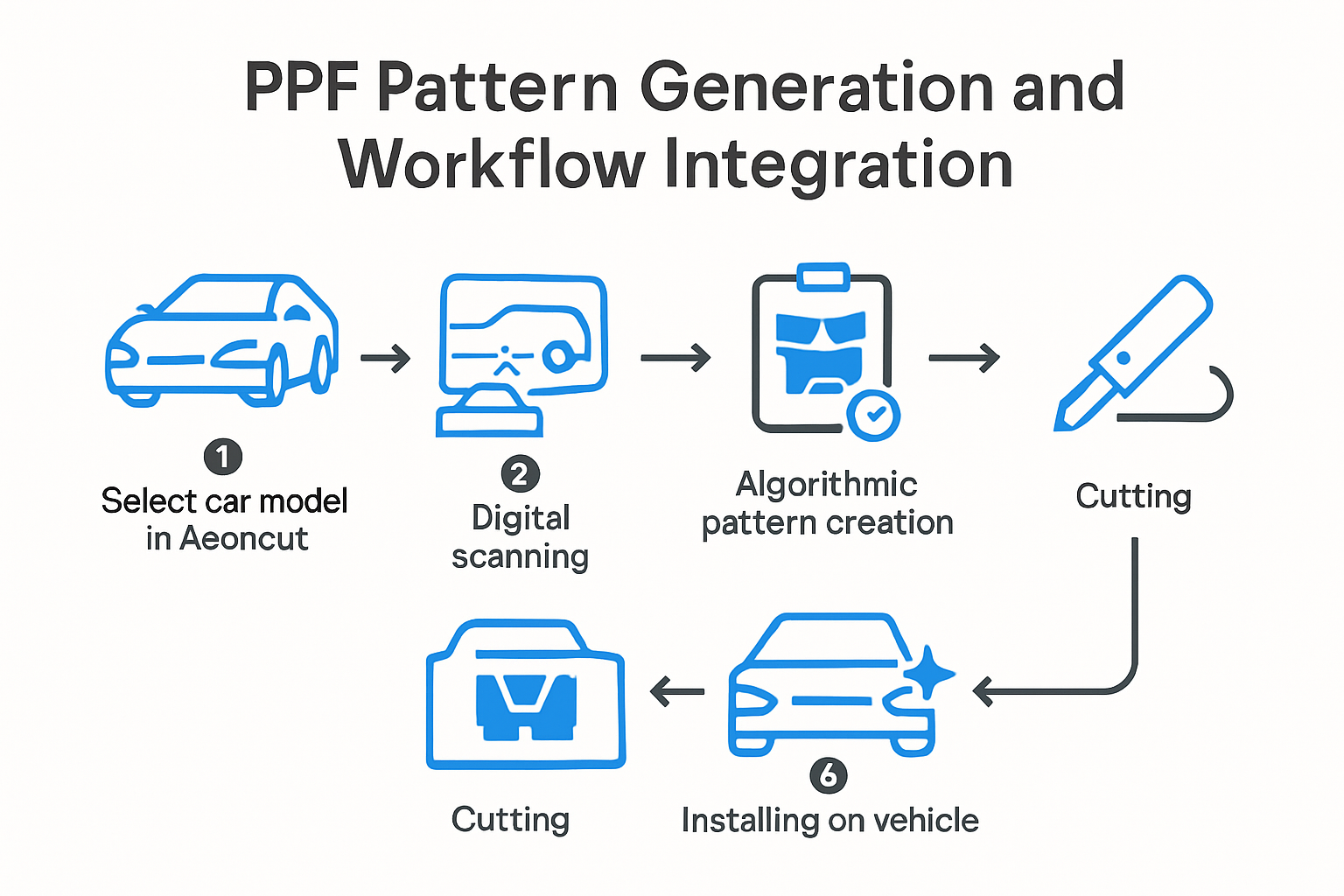
Workflow Optimization Techniques
Avery Dennison’s professional installation workshops emphasize the importance of integrating templating software into comprehensive installation processes. Professional installers can optimize their workflow by:
- Standardizing pattern preparation procedures
- Creating consistent material handling protocols
- Implementing quality control checkpoints
- Developing systematic installation documentation
These techniques transform pattern generation from a standalone task into an integrated component of a comprehensive protection strategy. Learn more about advanced PPF workflow techniques that can revolutionize your installation approach.
Advanced Digital Integration Methods
Digital patterning research highlights emerging technologies that are reshaping automotive protection film installations. Modern integration methods go beyond simple pattern generation, incorporating advanced features like:
- Augmented reality pattern overlays
- Real-time installation guidance
- Automated material usage calculations
- Comprehensive installation tracking
These technological advancements represent more than incremental improvements – they signify a fundamental transformation in how professional installers approach PPF application. By leveraging Aeoncut’s sophisticated computational capabilities, installers can achieve unprecedented levels of precision, efficiency, and consistency.
The future of PPF installation lies not just in cutting-edge software but in the seamless integration of digital intelligence with hands-on craftsmanship. Aeoncut bridges this gap, providing professionals with tools that enhance both technological capabilities and practical installation skills.
Frequently Asked Questions
How can I create custom PPF patterns using Aeoncut?
To create custom PPF patterns with Aeoncut, first prepare your digital workspace by selecting the vehicle model and configuring the software. Then, leverage Aeoncut’s advanced computational pattern generation algorithms to generate precise patterns based on the vehicle’s surface geometry. Finally, customize the patterns as needed to meet specific client requirements before proceeding to cut the film.
What are the advantages of using Aeoncut for PPF pattern design?
Aeoncut offers millimetre-level precision in pattern generation, optimising material coverage while minimising waste. Its advanced computational algorithms enable professional installers to create intricate patterns tailored to individual vehicle contours, significantly improving efficiency compared to manual methods.
How can I ensure accurate PPF cuts when using Aeoncut?
To achieve accurate PPF cuts, understand the material characteristics such as elasticity and compatibility with vehicle surfaces. Use advanced cutting techniques alongside Aeoncut’s software tools, which provide real-time guidance and mapping to help prevent common cutting errors and maintain consistent cutting depths.
What steps should I follow to optimise my installation workflow with Aeoncut?
To optimise your installation workflow with Aeoncut, standardise your pattern preparation procedures, create consistent material handling protocols, and integrate quality control checkpoints into your process. This ensures that digital pattern generation becomes a seamless part of your overall installation strategy, enhancing efficiency and accuracy.
Discover a Faster Way to Custom PPF Patterns with AEONCUT
If you have felt the frustration of slow, inaccurate manual pattern creation or tired of wasting PPF material due to imprecise cuts, you are not alone. The step-by-step guide above highlights that even experienced installers struggle with material optimisation and time management. What if you could generate ultra-precise, custom-fit vehicle patterns in minutes instead of hours? This is where AEONCUT PPF precut pattern solutions come into play, bringing advanced algorithms, cloud updates and an extensive PPF library straight to your workflow.

Ready to boost your precision and efficiency? Explore the complete library of PPF software and experience how automatic pattern generation and customisation can save you time and resources. Do not wait as the demand for seamless, accurate PPF installation is only rising. Visit aeoncutsw.com and transform your vehicle protection business today.
Recommended
- Home – AEONCUT PPF Pre-cut Cutting software
- Elevate Your 2025 Cupra Terramar Protection with AEONCUT’s PPF Software – AEONCUT PPF Pre-cut Cutting software
- Top 5 PPF and Tint Cutting Software for Professionals 2025 – AEONCUT PPF Pre-cut Cutting software
- How to Make PPF Software for Your Brand in 2025 – AEONCUT PPF Pre-cut Cutting software
